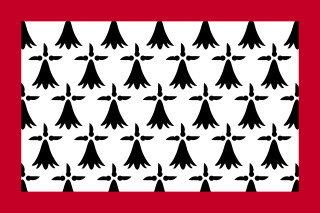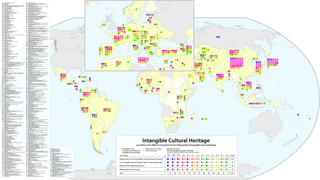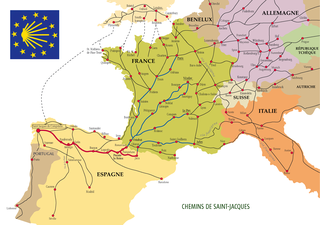Gallery
- 2009 by FCL
The Limousin septennial ostensions is a series of religious processions in commemoration of the relics of Roman Catholic saints in Limousin, France. [1]
The ostensions were inscribed by UNESCO in 2013 (8.COM) on the Representative List of the Intangible Cultural Heritage of Humanity. [1]
Languedocien, Languedocian or Lengadocian, is an Occitan dialect spoken in rural parts of southern France such as Languedoc, Rouergue, Quercy, Agenais and Southern Périgord. It is sometimes also called Languedocien-Guyennais. Due to its central position among the dialects of Occitan, it is often used as a basis for a Standard Occitan.

Arrested decay is a term coined by the State of California, United States to explain how it would preserve its Bodie State Historic Park. A more common application of this concept is the preservation of war ruins as memorials.
Legend tripping is a name bestowed by folklorists and anthropologists on an adolescent practice in which a usually furtive nocturnal pilgrimage is made to a site which is alleged to have been the scene of some tragic, horrific, and possibly supernatural event or haunting. The practice has been documented most thoroughly to date in the United States.

Limousin is a dialect of the Occitan language, spoken in the three departments of Limousin, parts of Charente and the Dordogne in the southwest of France.

The Périgord is a natural region and former province of France, which corresponds roughly to the current Dordogne department, now forming the northern part of the administrative region of Nouvelle-Aquitaine. It is divided into four areas called the Périgord Noir (Black), the Périgord Blanc (White), the Périgord Vert (Green) and the Périgord Pourpre (Purple). The geography and natural resources of Périgord make it an unspoiled region rich in history and wildlife, and the newly created Parc Naturel Régional Périgord-Limousin aims to conserve it as such.
An ostensive definition conveys the meaning of a term by pointing out examples. This type of definition is often used where the term is difficult to define verbally, either because the words will not be understood or because of the nature of the term. It is usually accompanied with a gesture pointing to the object serving as an example, and for this reason is also often referred to as "definition by pointing".

The Septennial Act 1716, also known as the Septennial Act 1715, was an Act of the Parliament of Great Britain. It was passed in May 1716. It increased the maximum length of a parliament from three years to seven. This seven-year ceiling remained in law from 1716 until 1911. The previous limit of three years had been set by the Triennial Act 1694, enacted by the Parliament of England.

Limousin is a former administrative region of southwest-central France. On 1 January 2016, it became part of the new administrative region of Nouvelle-Aquitaine. It comprised three departments: Corrèze, Creuse, and Haute-Vienne.

The Causses are a group of limestone plateaus in the Massif Central. They are bordered to the north-west by the Limousin and the Périgord uplands, and to the east by the Aubrac and the Cévennes. Large river gorges cut through the plateau, such as the Tarn, Dourbie, Jonte, Lot and Aveyron. Causse is an Occitan word meaning "limestone plateau".

The Limousin, French: Limousine, is a French breed of beef cattle from the Limousin and Marche regions of France. It was formerly used mainly as a draught animal, but in modern times is reared for beef. A herd book was established in France in 1886. With the mechanisation of agriculture in the twentieth century, numbers declined. In the 1960s there were still more than 250 000 head, but the future of the breed was not clear; it was proposed that it be merged with the other blonde draught breeds of south-western France – the Blonde des Pyrénées, the Blonde de Quercy and the Garonnaise – to form the new Blonde d'Aquitaine. Instead, a breeders' association was formed; new importance was given to extensive management, to performance recording and to exports. In the twenty-first century the Limousin is the second-most numerous beef breed in France after the Charolais. It is a world breed, raised in about eighty countries round the world, many of which have breed associations.
Ostension is the act of showing or demonstrating something.

Vivaro-Alpine is a variety of Occitan spoken in southeastern France and northwestern Italy. There is also a small Vivaro-Alpine enclave in the Guardia Piemontese, Calabria, where the language is known as gardiòl. It belongs to the Northern Occitan dialect bloc, along with Auvergnat and Limousin. The name “vivaro-alpine” was coined by Pierre Bec in the 1970s. The Vivaro-Alpine dialects are traditionally called "gavot" from the Maritime Alps to the Hautes-Alpes.

Abzac is a commune in the Charente department in the Nouvelle-Aquitaine region of southwestern France.

Kangaba is a town, commune, and seat of the Kangaba Cercle in the Koulikoro Region of south-western Mali.

UNESCO established its Lists of Intangible Cultural Heritage with the aim of ensuring better protection of important intangible cultural heritages worldwide and the awareness of their significance. This list is published by the Intergovernmental Committee for the Safeguarding of Intangible Cultural Heritage, the members of which are elected by State Parties meeting in a General Assembly. Through a compendium of the different oral and intangible treasures of humankind worldwide, the programme aims to draw attention to the importance of safeguarding intangible heritage, which UNESCO has identified as an essential component and as a repository of cultural diversity and of creative expression.

UNESCO designated the Routes of Santiago de Compostela in France as a World Heritage Site in December 1998. The routes pass through the following regions of France: Aquitaine, Auvergne, Basse-Normandie, Bourgogne, Centre, Champagne-Ardenne, Ile-de-France, Languedoc-Roussillon, Limousin, Midi-Pyrénées, Picardie, Poitou-Charentes, and Provence-Alpes-Côte d'Azur. UNESCO cites the routes' role in "religious and cultural exchange", the development of "specialized edifices" along the routes, and their "exceptional witness to the power and influence of Christian faith among people of all classes and countries in Europe during the Middle Ages".

The Dordogne is a river in south-central and southwest France. It is 483.1 km (300.2 mi) long. The Dordogne and its watershed were designated Biosphere Reserve by UNESCO on July 11 2012.

Nouvelle-Aquitaine or New Aquitaine, is the largest administrative region in France, spanning the west and southwest of the mainland. The region was created by the territorial reform of French regions in 2014 through the merger of three regions: Aquitaine, Limousin and Poitou-Charentes. It covers 84,036 km2 (32,446 sq mi) – or 1⁄8 of the country – and has 5,956,978 inhabitants. The new region was established on 1 January 2016, following the regional elections in December 2015.

Ostension: Word Learning and the Embodied Mind is a 2014 book by Chad Engelland in which the author provides a philosophical introduction to ostension and its significance in word learning.
The Miracula sancti Martialis anno 1388 patrata is a dossier of 73 miracles performed through the intercession of Saint Martial between 1378 and 1388. The Latin manuscript was found in the seminary of Nîmes by the Bollandists François Arbellot and Charles De Smedt, who edited and published it.